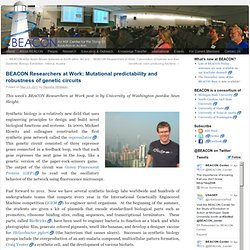

Darwin Manuscripts Project.
The Molecular Programming Project - Caltech - U. Origin. Cat. Experiment. Blogs. Analysis. Multicellularity. The Paleobiology Database. Biodiversity Heritage Library. Current Book List General Index Search Charles Darwin's Library Charles Darwin’s Library is a digital edition and virtual reconstruction of the surviving books owned by Charles Darwin.

This BHL special collection draws on original copies and surrogates from other libraries. It also provides full transcriptions of his annotations and marks. In this first release (2011) we provide 330 of the 1480 titles in his library, concentrating on the most heavily annotated books. more... How to use Charles Darwin's Library A Darwin’s Library transcription pane faces each page that Darwin marked or wrote notes on. Entries in the pane have line numbers, such as lines 5-7. In books scanned from Darwin’s personal copies you will see his writing. Click the banner to reach the Current Book List and the General Index.
The pane uses a very few specialized terms and symbols: The transcription pane uses special characters to represent some elements of Darwin's annotations. Support United Kingdom United States. Experimental evolution. Evolution experiments throughout human history[edit] Unwittingly, humans have carried out evolution experiments for as long as they have been domesticating plants and animals.

Selective breeding of plants and animals has led to varieties that differ dramatically from their original wild-type ancestors. Examples are the cabbage varieties, maize, or the large number of different dog breeds. The power of human breeding to create varieties with extreme differences from a single species was already recognized by Charles Darwin.
In fact, he started out his book The Origin of Species with a chapter on variation in domestic animals. Altogether at least a score of pigeons might be chosen, which if shown to an ornithologist, and he were told that they were wild birds, would certainly, I think, be ranked by him as well-defined species. Early experimental evolution[edit] Drawing of the incubator used by Dallinger in his evolution experiments. Modern experimental evolution[edit] NERE Home Page. List of Experimental Evolution Investigators. Experimental evolution PI pubmed search. Center for the Study of Evolution in Action. BEACON Researchers at Work: Mutational predictability and robustness of genetic circuits. This week’s BEACON Researchers at Work post is by University of Washington postdoc Sean Sleight.

Synthetic biology is a relatively new field that uses engineering principles to design and build novel biological functions and systems. In 2000, Michael Elowitz and colleagues constructed the first synthetic gene network called the repressilator. This genetic circuit consisted of three repressor genes connected in a feedback loop, such that each gene represses the next gene in the loop, like a genetic version of the paper-rock-scissors game. The output of the circuit was Green Fluorescent Protein (GFP) to read out the oscillatory behavior of the network using fluorescence microscopy.
Fast forward to 2011. Besides its numerous applications, synthetic biology is also a powerful system for studying evolution. Can mutational robustness be increased by removing the sequence similarity between the first and second terminators? References: Sleight S.C., B.A. NESCent: The National Evolutionary Synthesis Center. Dryad Home.